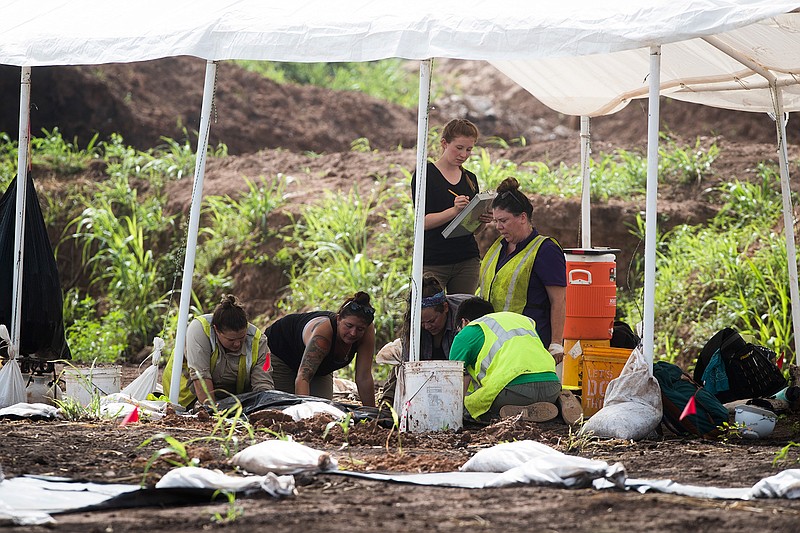SUGAR LAND, Texas-As Fort Bend Independent School District Superintendent Charles Dupre visited a construction site where dozens of unmarked graves were found near Sugar Land, he thought about the lives of the people buried there.
The Houston Chronicle reports archaeologists have determined that the remains found so far are of African-Americans, all but one of whom was male. The bodies have muscular builds and appear to have completed a lot of heavy labor from a young age. They range in age from teenagers to 70, and it is believed that they were part of the state's notorious convict-leasing system from the decades after the Civil War.
Photo Gallery
Red Octopus Christmas Show
At Riverdale 10 theater in Little Rock, Wednesday December 10.
Four months after Fort Bend ISD announced the discovery of the unmarked graves, historical and archaeological experts provided new details about the remains during a recent tour of the area. Laid out on a table were rusting artifacts found at the construction site of the district's new James Reese Technical Center.
The brown building frame of the new center could be seen in the distance, a short distance from white tents where remains were being examined.
Representatives from the Texas Historical Commission, Goshawk Environmental Consulting Inc., and school officials gathered to discuss recent developments in a mystery that has engrossed the community.
A judge in June authorized the school district to exhume remains found at the construction site, allowing the district to learn more about the 95 remains discovered so far.
Catrina Whitley, a bioarcheologist with Goshawk Environmental Consulting, said 48 remains had been uncovered since the exhumations began last month, but only 25 had been completely analyzed.
Whitley and Reign Clark, the cultural resources director for Goshawk, described the tedious process that archaeologists were undertaking to learn more about the remains.
During the exhumation process, archaeologists dig within the grave shaft to find the skeletal remains. The remains are then exposed, mapped, washed, photographed, X-rayed and analyzed.
Through the analysis, archeologists have determined the race, approximate age and physical makeup of those buried there. For example, the bodies range in height from 5 feet, 2 inches to 6 feet, 2 inches tall.
Some of the individuals display health stressors, which they can determine from heavy lines in their teeth. Experts concluded that some were extremely malnourished or had detrimental health problems when they were children, according to Whitley.
Whitley said that if the population of those found continues to be all male, then they are most likely from the convict leasing era, when prisoners, mainly African-Americans, were leased out to perform cheap labor. However, if more bodies are found to be women and children, then that may change their conclusions.
"With a slave population, I would expect to see children and more women that are buried because that would just be the cemetery for that slave population," Whitley said.
"The fact that right now it's all male but one female really leans us towards that interpretation at the moment."
The process could take several more months to complete, according to Whitley. On average, it can take 36 to 48 hours to excavate a single interment, according to Clark.
The school district announced the discovery of the remains last April. More bodies were found in the ensuing days.
The school district last year began building the new technical center at University Boulevard and Chatham to offer advanced junior- and senior-level courses. The center is named after James Reese, a former FBISD math teacher and its first vocational director, and is expected to open in the fall of 2019.
Clark, who showed off artifacts found within the burial site such as a brick and chains, said they have estimated the burials took place from 1878 to around 1911, which makes them more confident the bodies are from the convict leasing era.
Reginald Moore, a community activist who has long advocated for the nearby Old Imperial Farm Cemetery, had warned school officials not to build the technical center in the vicinity.
He has long believed that neighboring tracts contained the remains of those who'd been part of the convict leasing system, which allowed private companies to profit from the labor of convicts. In the decades after slavery ended, they worked on sugar-cane plantations in conditions so bad that Sugar Land was nicknamed the "Hell-hole on the Brazos."
Patricia Mercado-Allinger, the archaeology division director for the Texas Historical Commission, urged community members who believe they may have descendants buried at the site or know more about the history to come forward. To learn more about the remains, Whitley said, complete DNA analyses could be performed of potential relatives or other descendants.
When Moore toured the site separately last month, he said, he became consumed with emotion.
He is still advocating for a museum to be built to honor the history of those buried there.
"When I actually saw those skeletal remains, it connected me to the individual," Moore said.
"They became individuals, not skeletons. It was overwhelming to me to actually see the people who had been victimized inhumanely."


